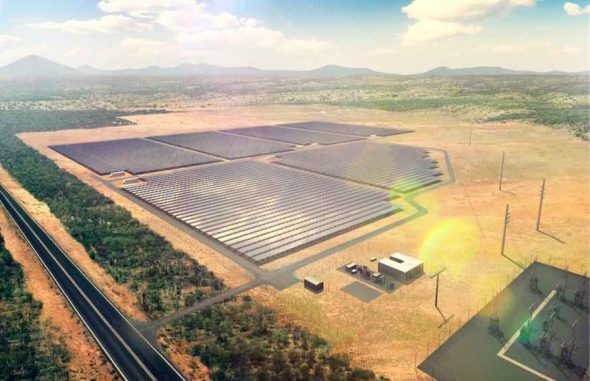A world leading large-scale solar and battery storage project in north Queensland has drawn interest from the world’s biggest miner, BHP Billiton, which says it is looking at the technology for its remote and off-grid mine sites.
The project, near Lakeland south of Cooktown, will combine 10.4MW of solar PV with 1.4MW/5.3MWh of lithium-ion battery storage, and is being pitched as a world-first for remote, edge of grid technology, and one likely to trigger a host of similar projects across Australia.

It was announced on Tuesday that the $42.5 million project, being developed by German-based Conergy, will get $17.5 million in funds from the Australian Renewable Energy Agency, and has also signed a power purchase agreement with Origin Energy.
That will be Origin’s fourth PPA with a solar project in the last few months, following its deals with Moree, Clare, and the Degrussa mine facility. Three of these have been co-funded by ARENA, and two of these – Lakeland and Degrussa – have been paired with battery storage.
This is where BHP Billiton’s interest has been pricked. The head of environment at BHP Billiton, Dr Graham Winkelman, says solar and storage projects may help BHP Billiton reduce its own operating emissions while helping to support energy reliability at some of the more remote operations.
BHP Billiton is tipping $350,000 into the “knowledge sharing” aspects of the project, small change for a company of its size, but it recognises the potential because of the number of its own operations that are in remote locations, far from infrastructure or on the fringe of grids. Energy security, through battery storage, is also an issue.
“The applications for mining could be enormous,” the company says. “The Lakeland Solar and Battery Storage Project will allow us to understand behaviour and performance of solar and storage systems with network and industrial loads.
“It is also an important component of Low Emissions Technology that provides balance to our portfolio. More broadly, battery storage is a key piece in the advancement of renewables and realising their potential to reduce emission on a larger industrial scale.”
There are now a growing number of solar and storage projects under construction or already running in Australia, including Degrussa and Weipa mines, along with off-grid projects such as Coober Pedy, Rottnest Island, King Island, and Flinders Island.
BHP has been operating a 1MW solar plant at the township adjacent to one of its copper mines in Chile, and it has previously canvassed solar and other renewable technologies when it put together its draft planning for the massive Olympic Dam project, although that whole project is now on hold.
ARENA chief executive Ivor Frischknecht said the ground breaking aspect of the project was its ability to operate in “island mode”, including in the evening peak, meaning that it could still supply power when the main transmission lines were cut due to storms or some other technical issue.
This is critically important for the likes of Ergon Energy, which runs the world’s most elongated and least populated grid, and which is looking at solar and storage options as an alternative to investing in upgrades of poles and wires and transformers in other locations in western and northern Queensland.
“Batteries are already competitive for particular situations,” Frischknecht told RenewEconomy. “They are not competitive right now with coal or gas generation, but that is not what we are trying to do.”
In a statement, he said: “The global energy transition is happening faster than many anticipated and Australia is well placed to be a key player. Our growing expertise in integrating renewables and batteries could readily translate into economic opportunities including export dollars in world markets.”
ARENA has now funded more than 200 different projects, but its future is under a cloud because of Coalition government proposals to remove its remaining legislated funds of $1.3 billion.
It has now amended that to cutting $1 billion as part of the omnibus budget repair package it intends to present to parliament, drawing on declared Labor policies announced in the recent election campaign. Labor has yet to say if it really intends to vote for the effective destruction of an agency it created during the Gillard government.
Conergy Australia managing director David McCallum said there was an immense opportunity in Australia for the widespread use of utility-scale batteries to store surplus power from excess solar generation for use during cloud cover, night-time and peak times.
“Utility-scale solar and storage, combined with effective management software, is the Holy Grail of the global renewable energy industry, and with this project we are well within reach of it,” he said in a statement, adding that this would decrease demand on both traditional generation and grid infrastructure.
The project will use the 1.4MW/5.3MWh ‘CHESS’ (Conergy Hybrid Energy Storage Solution) product designed by Conergy, with software and electronics provided by Autarsys GmbH. It will create a consistent power supply, even during times of cloud cover, and will produce enough electricity to power the equivalent of over 3,000 homes day and night.
Other larger solar and storage projects are also on the cards, including the Kingfisher project in South Australia, which is looking at a 20MW solar plus 2MW battery storage facility as a precursor to a 100MW solar PV plus 40MW battery storage project near Roxby Downs, on the main transmission line leading to BHP’s Olympic Dam project.
Construction at Lakeland will begin in September and is due to be completed in April next year. Germany’s Norddeutsche Landesbank Girozentrale (Nord/LB) provided a 15-year non-recourse financing facility for the project, and Norton Rose Fulbright provided legal counsel to Conergy.








